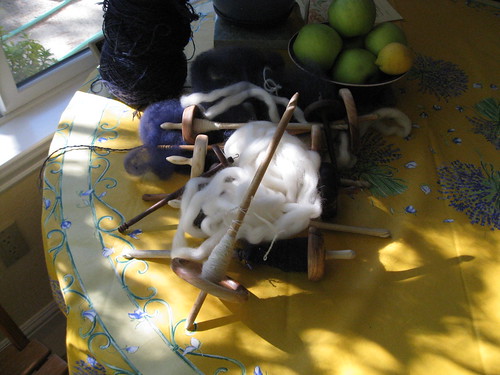Knitters talk about how warm a lace shawl is -- that is silly. Lace shawls are only "warm" in the context of a very mild environment, generally the result of central heat and heated transport.
Ladies that think lace shawls are "warm" have been the primary market for yarn mills for the last 100 years. The yarn companies have adapted. For the last 100 years, few people have worn hand knit work clothes, and the wool industry has adapted. The ladies want softer yarns, so the yarn companies make softer yarns. Now, if you go to a ski resort, you do not see wool sweaters on the ski slopes, you see them in the (heated) restaurants and in the (heated) lodge in the evening sitting by the fire. Nobody is asking for the more durable fibers, so the wool industry stops growing them, and the yarn industry has stopped spinning them into yarns for hand knitting.
The result is that there are likely 20 good yarn stores within 30 miles of my house, and not one of them carries a a single yarn containing any of the high luster, traditional British long wools. Even if I mail order "5-ply gansey yarn" from the UK, none of the 4 brands in my stash have any long wool in them. However, if we look at the pictures in Gladys Thompson's Patterns for Guernseys, Jerseys and Arans, we see that high luster long wool was used for every object except the Aran patterns. This tells us that yarns really have changed in the last 55 years since GT was first published. What does this mean?
It means that if you buy a "5-ply gansey yarn", it will be spin from fine, short fiber. It will not be nearly as durable as a yarn spun from long wool. The fibers are thiner and will not tolerate abrasion as well as the coarser long wool fibers. The fibers are shorter and more likely to pull out of the yarn, and the yarn will fall apart if the object is worn for an extended period of time while wet. To hold the shorter fibers in place the yarn has more twist and ply and thus is stiffer and requires more effort to knit into a weatherproof fabric. On the other hand, the high twist yarn shows off cables even when knit loosely. These are yarns that have evolved to meet needs of personal adornment, rather than the practical needs of a waterman. These are yarns of status rather than for warmth.
Seeking more durable yarns for outer wear, you are likely to find MacAusland's Woolen Works and Cottage Craft in the Atlantic Provinces of Canada. These are 2-ply and 3-ply yarns that are spun semi-woolen or semi-worsted. With their coarser fibers and woolen nature, these yarns do have a certain itch factor when worn next to the skin. With their thick plies, these yarns require great effort to knit tight enough to be weatherproof. And, when knit tight enough to be really warm, these yarns produce a fabric that is stiff. On the other hand, I have worn sweaters that were hand knit from these yarns to keep me warm and comfortable while pruning apple trees in fierce storms. With their coarse fiber, these yarns are relatively durable. And, over all, they are the most comfortable garments that I have ever worn skiing.
What were the virtues that caused the old knitters to use long wool 5-ply gansey yarn when knitting "ganseys"? First there was cost, long wool was plentiful and less expensive. There was durability; both the thickness of the fiber and the length of the fiber contributed to produce a very durable fabric that was tough enough to be workman's clothing in an industrial environment (ships). The yarn was very supple which allowed it to be knit tight enough to be weatherproof and yet the fabric remain flexible and elastic, and thus very comfortable. The worsted spun structure resulted in a smooth surface, that while not soft, was pleasant to the touch. Thus, it produced a relatively thin fabric that was light in weight, flexible, and very durable. This met the needs of a sailor working in the rigging above deck, or sleeping in his hammock, or indeed anyone working on the water.
There are a lot of farm stores selling yarns spun from long wools. Some are even an appropriate "sport' weight. However, they are 2 and 3-ply, which do not have the durability or suppleness of 5-ply. Further more, the the fibers for these yarns "have been through the mill". That is, they have been commercially processed to remove vegetable matter, and subjected to aggressive picking and carding. This is much harder on fibers than hand combing. Thus, the fibers in the yarns sold by "farm stores' tend to be shorter than the fibers in the fleeces sold by the same farm stores. There are two reasons for this. The fleeces with shorter fibers tend to be the ones sent to the mill for spinning into yarn, while fleeces with longer fibers are sold to hand spinners. And, mills tend to break fibers.
Thus, at this instant, if you want to understand why people made such a fuss over British seaman's ganseys, you are going to have to hand spin your own yarn and knit it yourself. In fact the whole British tradition of knitting yarns consisting of long wool spun into fine singles and plied up into 3-ply fingerling, 4- ply, and 5-ply is well worth investigating for anyone that is interested in light weight, but very warm and supple clothing.

.jpg)